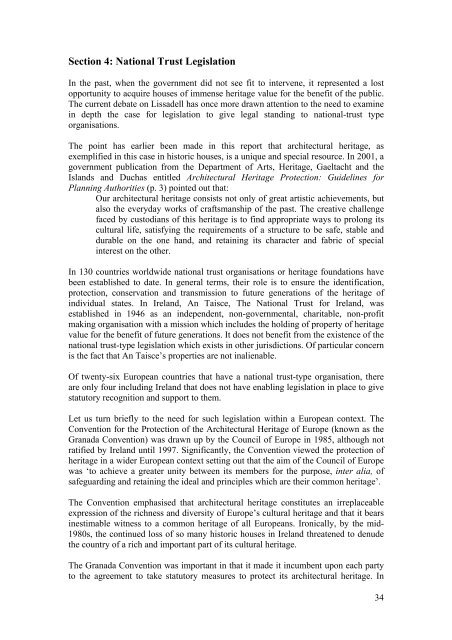A Future for Irish Historic Houses - Irish Heritage Trust
A Future for Irish Historic Houses - Irish Heritage Trust
A Future for Irish Historic Houses - Irish Heritage Trust
You also want an ePaper? Increase the reach of your titles
YUMPU automatically turns print PDFs into web optimized ePapers that Google loves.
Section 4: National <strong>Trust</strong> Legislation<br />
In the past, when the government did not see fit to intervene, it represented a lost<br />
opportunity to acquire houses of immense heritage value <strong>for</strong> the benefit of the public.<br />
The current debate on Lissadell has once more drawn attention to the need to examine<br />
in depth the case <strong>for</strong> legislation to give legal standing to national-trust type<br />
organisations.<br />
The point has earlier been made in this report that architectural heritage, as<br />
exemplified in this case in historic houses, is a unique and special resource. In 2001, a<br />
government publication from the Department of Arts, <strong>Heritage</strong>, Gaeltacht and the<br />
Islands and Duchas entitled Architectural <strong>Heritage</strong> Protection: Guidelines <strong>for</strong><br />
Planning Authorities (p. 3) pointed out that:<br />
Our architectural heritage consists not only of great artistic achievements, but<br />
also the everyday works of craftsmanship of the past. The creative challenge<br />
faced by custodians of this heritage is to find appropriate ways to prolong its<br />
cultural life, satisfying the requirements of a structure to be safe, stable and<br />
durable on the one hand, and retaining its character and fabric of special<br />
interest on the other.<br />
In 130 countries worldwide national trust organisations or heritage foundations have<br />
been established to date. In general terms, their role is to ensure the identification,<br />
protection, conservation and transmission to future generations of the heritage of<br />
individual states. In Ireland, An Taisce, The National <strong>Trust</strong> <strong>for</strong> Ireland, was<br />
established in 1946 as an independent, non-governmental, charitable, non-profit<br />
making organisation with a mission which includes the holding of property of heritage<br />
value <strong>for</strong> the benefit of future generations. It does not benefit from the existence of the<br />
national trust-type legislation which exists in other jurisdictions. Of particular concern<br />
is the fact that An Taisce’s properties are not inalienable.<br />
Of twenty-six European countries that have a national trust-type organisation, there<br />
are only four including Ireland that does not have enabling legislation in place to give<br />
statutory recognition and support to them.<br />
Let us turn briefly to the need <strong>for</strong> such legislation within a European context. The<br />
Convention <strong>for</strong> the Protection of the Architectural <strong>Heritage</strong> of Europe (known as the<br />
Granada Convention) was drawn up by the Council of Europe in 1985, although not<br />
ratified by Ireland until 1997. Significantly, the Convention viewed the protection of<br />
heritage in a wider European context setting out that the aim of the Council of Europe<br />
was ‘to achieve a greater unity between its members <strong>for</strong> the purpose, inter alia, of<br />
safeguarding and retaining the ideal and principles which are their common heritage’.<br />
The Convention emphasised that architectural heritage constitutes an irreplaceable<br />
expression of the richness and diversity of Europe’s cultural heritage and that it bears<br />
inestimable witness to a common heritage of all Europeans. Ironically, by the mid-<br />
1980s, the continued loss of so many historic houses in Ireland threatened to denude<br />
the country of a rich and important part of its cultural heritage.<br />
The Granada Convention was important in that it made it incumbent upon each party<br />
to the agreement to take statutory measures to protect its architectural heritage. In<br />
34


